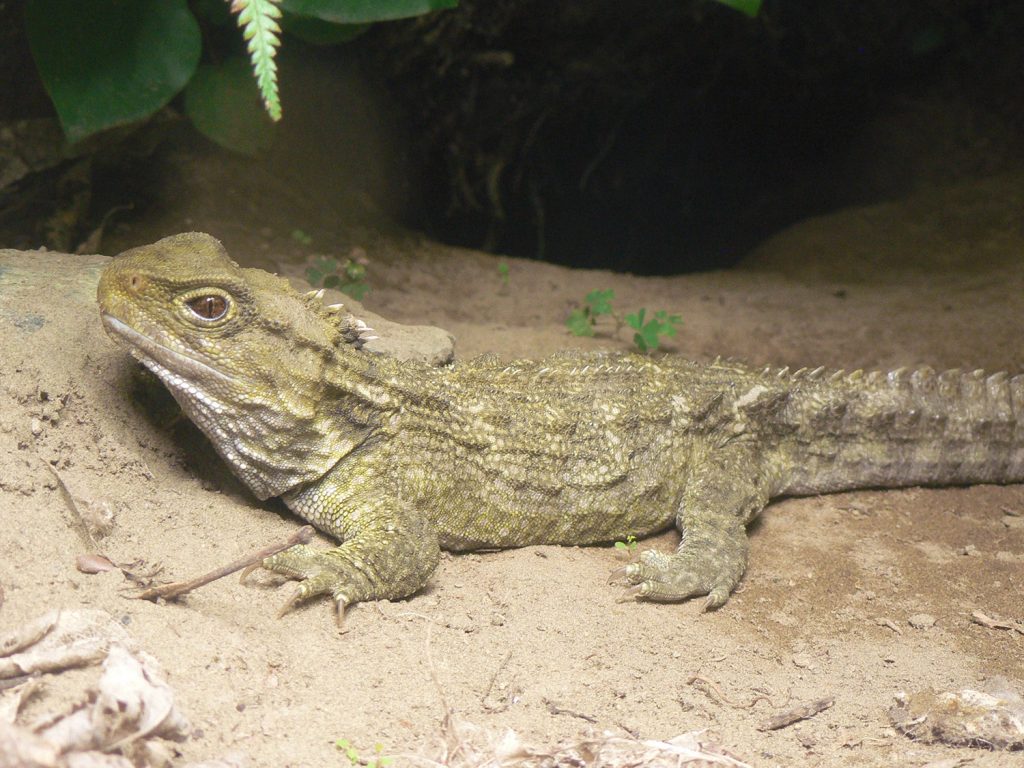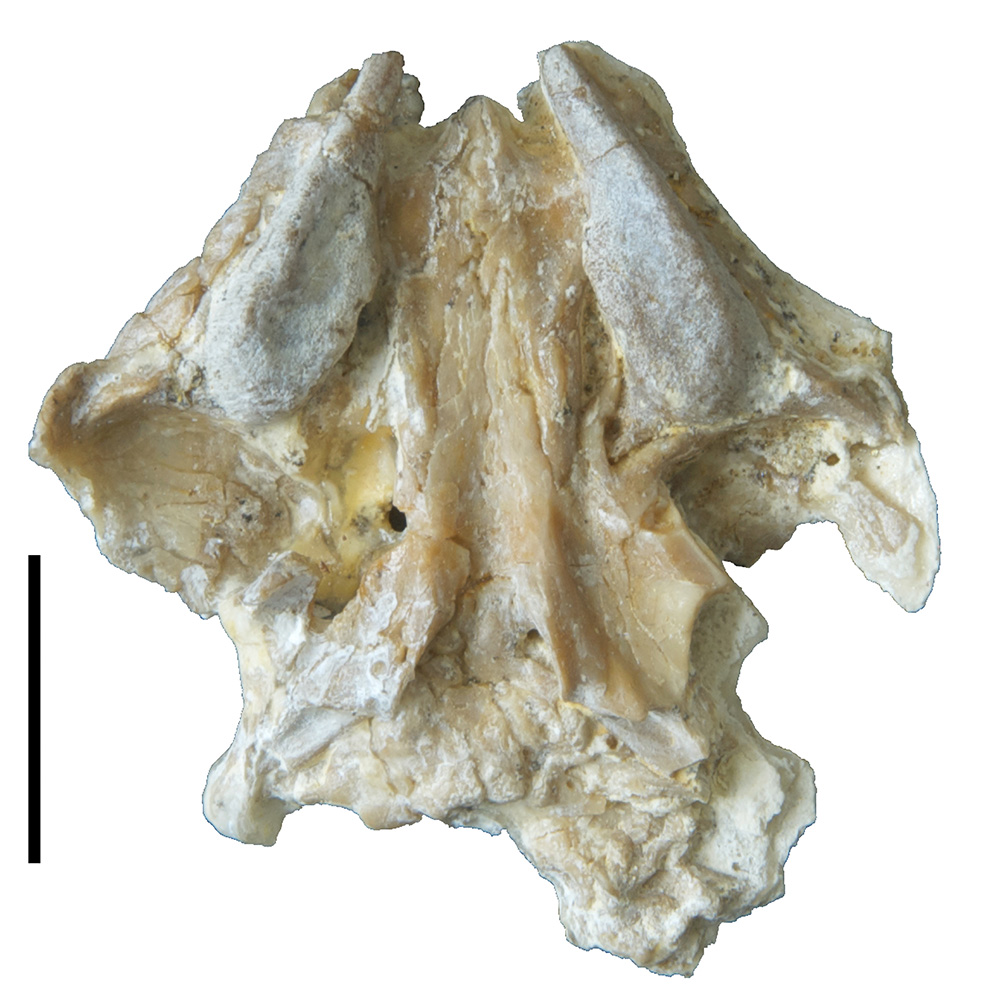With a crush: A Jurassic brother of the enigmatic tuataras
Bavarian State Collection for Palaeontology and Geology
Tuataras are often regarded as a classic example of a living fossil. They are the last survivors of an ancient lineage, which is said to have lost the evolutionary struggle with the modern lizards. A new find from the Late Jurassic (c. 148 Ma ago) of southern Germany demonstrates that the fossil relatives of the tuatara showed a much greater evolutionary plasticity than previously recognized and were at the height of their ecological diversity at a time, when modern lizards were already widespread. This challenges the idea of their evolutionary inferiority and suggests that other reasons might be responsible for their decline.
It looks like a “normal” lizard, but belongs to an ancient lineage apart from modern lizards: the Tuatara, which is represented by only two species that live on a few islands off the coast of New Zealand. With a brain and mode of locomotion that is said to be intermediate between amphibians and reptiles, tuataras are among the most enigmatic living animals and are often regarded as living fossils, as a perfect model for an ancient lizard ancestor. However, their parent lineage, the Rhynchocephalia (“Beak Heads”) were wide-spread and diverse during the Mesozoic, the “age of dinosaurs”. To answer the question what led to their decline in the late Mesozoic seemed easy enough: with their obviously primitive appearance, rhynchocephalians were clearly inferior to the true lizards and even more so to the primitve mammals that radiated at that time. Were they really?
A new fossil relative of the tuataras found in the latest Jurassic of southern Germany challenges this idea, in line with other recent finds of rhynchocephalians. In a paper recently published in the scientific journal PLoS One, the German brother of the tuataras was given the name Oenosaurus muehlheimensis, revering the exquisite wine of the Franconian Alb and the village of Mühlheim, close to the place where the fossil was found. Oenosaurus closely resembles the living tuataras, but it has a dentition that is unique amongst tetrapods. “When the specimen was found and only the palatal view of the skull was visible, we were all wondering what kind of animal it might be”, recalls Dr. Oliver Rauhut of the Bavarian State Collection for Palaeontology and Geology, the lead author of the study: “no one of us had ever seen such teeth in a reptile.” The dentition of Oenosaurus consists of massive tooth plates, the structure of which indicates that they might have been growing continuously, balanced by wear on the surface of the plate. Such teeth are otherwise only found in chimaeran and dipnoan fishes. “We analysed the tooth plates with the help of computer tomography, and when I showed the pictures to a colleague who is specialized in the microstructure of fish teeth, she first found nothing unusual – until I told her that these were the teeth of a reptile”, says Dr. Adriana López-Arbarello, fish expert of the State Collection and one of the co-authors of the paper. “Then she almost couldn’t believe it”, she adds with a little smile. This discovery represents a previously unknown trophic adaptation in rhynchocephalians, indicating a diet of hard-shelled organisms. Rhynchocephalians otherwise have a very specialized kind of dentition, well adapted to cutting or tearing functions, which has been hypothesized to limit their evolutionary adaptability. Thus, the dentition of Oenosaurus demonstrates an unexpected evolutionary plasticity in these animals and underlines the fact that rhyncocephalians were actually highly diverse, both morphological and ecological, during the latest Jurassic in Europe, just before the decline of this lineage on this continent. This contradicts the popular view that rhynchocephalians were inferior to lizards and early mammals and that selection pressure by these animals is sufficient to explain the demise of the group in the late Mesozoic; instead, climate change in the course of the fragmentation of the supercontinent of Pangaea might have played a major role.
The remains of Oenosaurus were found by Roland Pöschl in the outcrops of the Mörnsheim Formation in the Schaudiberg quarry in Mühlheim near Mörnsheim, central Bavaria, Germany. The owners of the quarry immediately recognized the scientific value of the fossil and kindly donated it to the Bayerische Staatssammlung für Paläontologie und Geologie in Munich. The Mörnsheim Formation is slightly younger than the well-known Solnhofen Formation, which, among others, has yielded the famous Urvogel, Archaeopteryx. The Mörnsheim Formation is also very fossiliferous, but much more poorly known, since, in contrast to the Solnhofen Formation, there are few commercial quarries in these rocks. “We have just begun to explore these rocks, and more surprises are sure to come”, affirms Alexander Heyng. The geologist analyses the succession of rocks in the Schaudiberg quarry and also arranged the contact between the quarry owners and the scientists of the Bavarian State Collection. A large part of the Schaudiberg quarry is now open for exploration by visitors (http://www.besuchersteinbruch.de/), who can get actively involved in the fascinating adventure of discovering the Jurassic life and further support scientist in the challenge of deciphering the early history and evolutionary pathways of the modern organisms.
Publication:
Rauhut OWM, Heyng AM, López-Arbarello A, Hecker A (2012) A New Rhynchocephalian from the Late Jurassic of Germany with a Dentition That Is Unique amongst Tetrapods. PLoS ONE 7(10): e46839. DOI: https://doi.org/10.1371/journal.pone.0046839
Contact:
Dr. Oliver Rauhut
Dr. Adriana López-Arbarello
Bavarian State Collection for Palaeontology and Geology (SNSB-BSPG)
Richard-Wagner-Str. 10
80333 Munich
E-Mail: a.Lopez-Arbarello@lrz.uni-muenchen.de
E-Mail: o.Rauhut@lrz.uni-muenchen.de
Tel.: +49 (0)89 2180 6725
The up to 50 cm long tuatara, Sphenodon punctatus, which lives on a few islands off New Zealand. Photo courtesy of Dr. Helmut Tischlinger. Palatal view of the skull of Oenosaurus, with the tooth plates clearly visible. Scale is 1 cm. Photo: SNSB-BSPG



